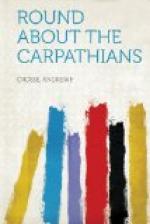Everywhere in Hungary the different races are strangely mixed up together: the Tokay Hegyalia, it is true, is chiefly peopled by Magyars, and the language is said to be the purest Magyar spoken anywhere; but there are Slavs and Jews amongst them, and our drive of twenty miles brought us into an area where the Slavs predominate. The difference of these races is very marked: the one, fair complexioned and blue eyed; the Magyar, dark, almost swarthy amongst the lower classes. At Olasz-Liszka, a small town within the Tokay district, there is an Italian colony, as the name Olasz (Italian) would imply. As long ago as the days of Bela II. this place was peopled by Italian immigrants from the neighbourhood of Venice, invited hither by the king, who greatly encouraged the cultivation of the vine.
Go where you will in this country, there is a Babel of tongues. In this instance our special coachman was a Bohemian, speaking his own language—a very different dialect from the Slovacks who were the “beaters” for our hunt. The gamekeepers, or rather the foresters (for the game is of secondary consideration), were all Magyars. Their language, as we know, bears no affinity to any of the rest. The marvel is that the world gets on at all down here. The gentlemen of our party spoke together indifferently German, French, and English.
It is curious to hear the peasant come out with, “Why the Tartar are you doing this?” for an angry expletive. It is a relic of the old troubled times when the country suffered from the frequent depredations of Turks and Tartars. The Tokay district, say the chronicles, was fearfully harassed by the Turks as late as 1678.
It is worth while recalling a contemporaneous fact. In 1529 the crescent had been substituted for the cross on the Cathedral of Vienna to propitiate the Turks, and it was not till 1683 that the symbol of the dreaded Moslem was removed. When the Hungarians ceased to fear the Turk, they ceased to hate him; and since 1848 they remember only the generous hospitality of the Porte, and the cruel aggressions and treachery of the Russians. The Slav has a longer memory, for to this day he repeats the saying, “Where the Turk comes, there no grass grows.”
When we arrived at our destination our appetites were far too keenly set to think about the Eastern Question, and right glad were we to see active preparations for supper. The national dishes, the gulyas hus and the paprika handl, were produced amongst a number of other good things, such as roast hare. You get to like the paprika, or red pepper, very much. I wonder it is not introduced into English cookery, it makes such a pretty-coloured gravy. If the traveller finds himself attacked by marsh fever, and should chance to be without quinine (a great mistake, by the way), let him substitute a spoonful of paprika mixed with a little red wine, repeating the dose every four hours if necessary. While smoking our peace-pipes after supper, one of the keepers came in to announce the welcome fact that it was snowing hard; fresh-lain snow would materially increase our chances of tracking the wild-boar.




